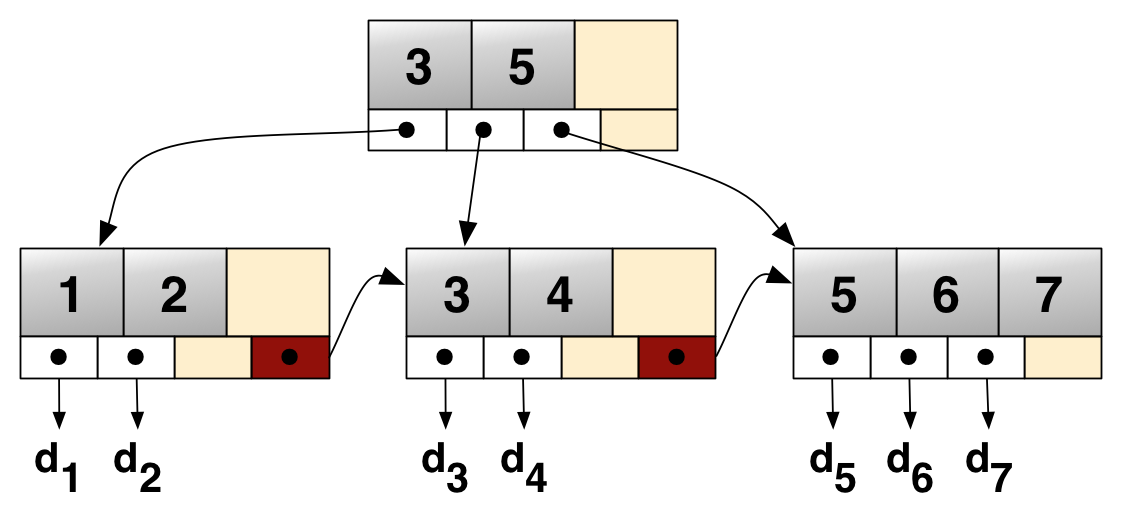8.5 Metadata
Metadata
- Data about data
- Information about where block of a file are stored
- File access control
- Dates and times
File Names
- Not really metadata
- Names provide a reference to a file
- Names are not a property of a file
- Multiple names can point to the same file
Data Location Metadata
- ext3 stores file metadata in blocks called inodes
- Each inode stores file metadata including data locations
- inodes are stored in a linear array
- Each file has a unique inode

Sparse Files
- It is not necessary for empty blocks to be backed by actual storage
- A large file use sparsely need not take up the full file size on disk
Example
> dd if=/dev/zero of=sparsefile count=0 bs=4k seek=1000000000
> ls -s sparsefile
0 -rw-rw-r-- 1 jncraton 3.8T Apr 6 09:11 sparsefilePOSIX Metadata
- Owner (number)
- Group (number)
- File mode (9 permission bits)
- Stored in inode
Other Metadata
- File size
- Modified, written, accessed times
- Count of names referencing this file
8.6 Directories and Indexing
Files
- Provide access to blobs of data
- Include names for easy access
- Stored in a hierarchy
Directories
- Provide hierarchical levels for storing files
- Each name in a director points to one file
- Names within a directory are unique
Unordered Linear List
- Simple
- Trivial O(1) modification
- O(n) lookup where n is number of files in directories
- Large number of files create inefficiency
Hash Tables
- O(1) lookup without collisions
- Does not provide a way to iterate names in order
B+-Tree
- Tree with large fan out to reduce number of lookups
- O(log n) search
- Internal nodes contain pointers to leaves and no values
- Nodes include links to next sibling to form a linked list

B+-Tree
- Commonly used for directory storage
- Used by NTFS (Microsoft), HFS (Apple), and XFS (open source)
8.7 Metadata Integrity
Buffering Writes
- Data to be written to disk is stored temporarily in RAM
- RAM loses state without power
- What happens to buffered writes when the system is power cycled?
Data Loss
- Buffered data will be lost
- Application programs need to be able to handle this
- Databases may solve this using a write-ahead log
Metadata Consistency
- Metadata must not become inconsistent
- Blocks that are in use must be marked as not available to others
- Blocks marked as in use should be pointed to by an inode
Irreparable Corruption
- Must be avoided
- Example is two files sharing an underlying data block
Noncritical Reparable Corruption
- Can be fixed after the fact
- Lost block in a single file
Critical Reparable Corruption
- Can be fixed after the fact
- Must be fixed before the system resumes it regular work
- Example is a block in use by a file but not marked as in-use
Consistency Strategies
- Journaling
- Shadow Paging
Journaling
- Each logical change is only a single block written to persistent storage
- This single block is the commit record for a transaction
- Partially complete transactions can be rolled back
- NTFS, HFS, ext3
Shadow Paging
- Creates new data structures instead of modifying existing structures
- Single block change updates pointer to current metadata structure
- ZFS, BTRFS
Snapshots
- If we select shadow paging, we can keep old metadata blocks around
- If we also create copies of blocks on write, we can cheaply store each state of the file system in time
- This can be very valuable in certain contexts
8.9 Security and Persistent Storage
Threat Model
- What are we trying to defend against?
- External vs internal attackers
- Physical access vs remote access
- Data loss vs data exfiltration
Encryption
- Data written to disk without encryption will be vulnerable to physical exfiltration
- This may be expensive
- This also applies to values in memory that have been swapped to disk
File Encryption
- Protect certain files from being accessed
- Does not protect swap
- Can lead to sensitive data being stored on the system
Full Disk Encryption
- FDE
- Encrypts all data on the drive
- Requires an encryption key in order to boot the system
Deleting Files
- In most file systems, data is left on a drive after file deletion
- Pointers to the file are what get removed
- File can be securely erased by overwriting their underlying data
- SSD data can’t be overwritten to wear level, but SSDs include a secure erase method